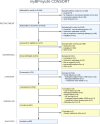Daily Dietary Sodium Intake Among Clinical Trial Participants Recruited From a University Health System or a Federally Qualified Health Center: Secondary Analysis of Baseline Participant Characteristics
- PMID: 40997343
- PMCID: PMC12463386
- DOI: 10.2196/71343
Daily Dietary Sodium Intake Among Clinical Trial Participants Recruited From a University Health System or a Federally Qualified Health Center: Secondary Analysis of Baseline Participant Characteristics
Abstract
Background: Efforts to improve diversity in clinical trials often prioritize recruitment based on broad demographic factors. This approach may overlook the influence of community context and health-related social needs on health behaviors, including sodium intake, a key modifiable risk factor for hypertension and cardiovascular disease.
Objective: This study aims to assess the impact of enrollment site, sociodemographic factors, and health-related social needs on baseline dietary sodium intake among participants in a mobile health clinical trial aimed at lowering blood pressure.
Methods: The myBPmyLife study is a prospective, randomized controlled trial evaluating a mobile health intervention to lower blood pressure through increased physical activity and lower sodium food choices. Participants with hypertension were recruited from a university health system and a federally qualified health center (FQHC). All participants completed a validated sodium screener at enrollment. Sociodemographic data and health-related social needs were self-reported. Univariable and multivariable linear regression models were used to evaluate the associations between sodium intake and participant characteristics. This analysis presents a cross-sectional examination of the baseline characteristics of participants enrolled in the myBPmyLife study.
Results: Among 600 included participants, 96 (16.0%) were from the FQHC. Mean age was 60.1 (SD 13.5) years; 48.2% (289/600) were women, and 13.0% (78/600) were Black. FQHC participants were significantly younger (mean age 47.9, SD 11.1 vs 62.5, SD 12.7 years), more likely to be Black (43/96, 44.8% vs 35/504, 6.9%), and 8.5 times more likely to have difficulty paying for their health-related social needs. Mean baseline sodium intake was 3082.3 (SD 1072.5) mg/day, with 85.5% (513/600) of participants exceeding the World Health Organization's recommended daily sodium limit. Baseline sodium intake was significantly higher for FQHC participants (mean difference 381.1, SD 1064.2 mg/d; 95% CI 84.5-677.7; P=.01), men (mean difference 543.9, SD 1038.3 mg/d; 95% CI 377.3-710.5; P<.001), Black participants (mean difference 442.5, SD 1043.4 mg/d; 95% CI 119.7-765.3; P=.008) and those with difficulty affording basic needs (mean difference 338.1, SD 1066.7 mg/d; 95% CI 95.2-581.0; P=.02). Sodium intake was lower in older participants (-196.4 mg/d per 10 years; 95% CI -258.0 to -134.9; P<.001). In a multivariable analysis, age, gender, and race remained independently associated with sodium intake, while differences by site and health-related social needs were not statistically significant.
Conclusions: Differences in sodium intake were observed across sociodemographic groups. While the enrollment site was not independently associated with sodium intake after adjustment, it played a role in shaping the participant population, evidenced by the differences in demographics and health-related social needs among participants based on enrollment site. These findings underscore the importance of recruiting from distinct clinical settings to capture a range of contextual factors that influence health behaviors. Clinical trials aiming for representativeness should consider both individual- and community-level factors during recruitment to more accurately inform interventions and health outcomes.
Keywords: blood pressure; cardiovascular diseases; clinical trial; dietary sodium; hypertension; sociodemographic factors; sodium consumption.
© Gabriella V Rubick, Michael P Dorsch, Scott L Hummel, Tanima Basu, Evan Luff, Kimberly Warden, Michael Giacalone, Sarah Bailey, Mark W Newman, Lesli E Skolarus, Brahmajee K Nallamothu, Jessica R Golbus. Originally published in JMIR Cardio (https://cardio.jmir.org).
Conflict of interest statement
SH receives grant funding from the VA (I01CXX001636). MWN receives funding from the National Heart, Lung, and Blood Institute and the National Institute on Drug Abuse. LES receives funding from the National Institute of Aging, the National Institute of Minority Health and Health Disparities, the National Institute of Neurological Disorders and Stroke, and the American Health Association. BKN receives compensation as editor-in-chief of Circulation: Cardiovascular Quality & Outcomes, a journal of the American Heart Association. He is a co-inventor on US Utility Patent Number US15/356,012 (US20170148158A1) entitled “Automated Analysis of Vasculature in Coronary Angiograms,” which uses software technology with signal processing and machine learning to automate the reading of coronary angiograms, held by the University of Michigan. The patent is licensed to AngioInsight, Inc, in which BKN holds ownership shares and receives consultancy fees. JRG receives funding from the National Heart, Lung, and Blood Institute (L30HL143700, 1K23HL168220) and Patient-Centered Outcomes Research Institute.
Figures
References
-
- Boden-Albala B, Waddy SP, Appleton N, Kuczynski H, Nangle E, Recruitment PNS. Recruitment, Inclusion, and Diversity in Clinical Trials. John Wiley & Sons; 2021. The science of health disparities research; pp. 413–428. doi. - DOI
-
- Watson NL, Mull KE, Heffner JL, McClure JB, Bricker JB. Participant recruitment and retention in remote eHealth intervention trials: methods and lessons learned from a large randomized controlled trial of two web-based smoking interventions. J Med Internet Res. 2018 Aug 24;20(8):e10351. doi: 10.2196/10351. doi. Medline. - DOI - PMC - PubMed
Publication types
MeSH terms
Substances
Grants and funding
LinkOut - more resources
Full Text Sources
Medical


